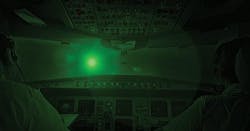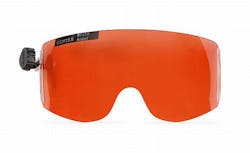Air Force lets multi-million-dollar contracts for pilot eye protection from military and civil laser attacks
Officials of the Air Force Life Cycle Management Center at Wright-Patterson Air Force Base, Ohio, announced contracts each worth as much as $98.3 million to the two companies on Friday for laser eye protection.
Gentex and Teledyne Scientific will develop and build different variants and sizes of laser eye protection for protecting aircrew against emerging laser attacks like laser dazzlers and lasers intended to blind air crews or cause permanent eye injury.
Military, commercial, and general-aviation aircraft pilots in recent years have come under increasing threat from ground-based lasers, ranging from common laser pointers to sophisticated laser dazzlers from hostile military forces.
Related: Army to kick off industry competition for next-generation laser-protecting eyewear
Sometimes these lasers cause temporary blindness and disorientation -- particularly at night -- when the eyesight of air crews has adjusted to darkness. Other cases can cause permanent blindness or eye injury, depending on the type and strength of the laser.
Last June U.S. officials reported that U.S. military pilots flying over the East China Sea had been targeted by blinding laser attacks from shore sites and from fishing boats more than 20 times over the previous 10 months.
In fact, the number of laser attacks on U.S. pilots in the Middle East and South China Sea areas could top the roughly 600 incidents reported in 2016 and match 2015, when about 700 incidents were reported in the Middle East, officials say.
Gentex makes the dazzle laser defense visor for mounting to flight helmets to protect civil and military pilots from a variety of laser attacks. These visors are designed to protect pilots from low-intensity lasers without compromising visual acuity.
Teledyne Scientific, meanwhile, makes the aircrew laser eye protection (ALEP) devices, of which more than 10,000 have been delivered to the Air Force, company officials say.
On these contracts, Gentex will do the work in Simpson, Pa.; and Teledyne Scientific will to the work in Thousand Oaks, Calif. Both companies should be finished by September 2024.
For more information contact Gentex Corp. online at https://gentexcorp.com, Teledyne Scientific & Imaging at www.teledyne-si.com, or the Air Force Life Cycle Management Center at www.wpafb.af.mil/aflcmc.
Ready to make a purchase? Search the Military & Aerospace Electronics Buyer's Guide for companies, new products, press releases, and videos

